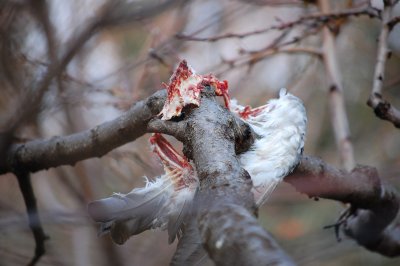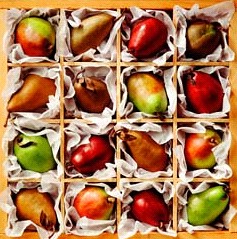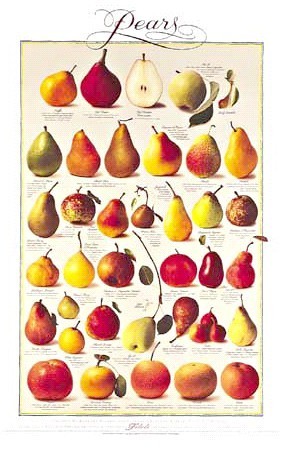 |
Nature in the City
When the Cooper’s hawks are hanging in my, South Philly / Italian Market, backyard I can’t tear my eyes off them!
But I guess a pigeon wing in the peach tree is the down side.
Photo by Elizabeth Fiend
 |
Nature in the City
When the Cooper’s hawks are hanging in my, South Philly / Italian Market, backyard I can’t tear my eyes off them!
But I guess a pigeon wing in the peach tree is the down side.
Photo by Elizabeth Fiend
WARM PEAR SALAD with GORGONZOLA and WALNUTS
BY ELIZABETH FIEND
Serves 4 as lunch or main course, 6 as a side salad
Time: 20 minutes
Category: Vegetarian Recipe
 |
 |
 |
This salad is all about contrasts.
The pears are served warm, making this a great dish to serve on a chilly, rainy day. The sharp cheese, crunchy nuts and creamy honey-lime dressing each stimulate different taste buds providing satisfaction and a feeling of fullness. I’ve divided up one serving between the cheese and nuts so even thought you’ll be eating cheese AND nuts (both contain fat) you will be getting just the right amount of fat and protein.
There’s an optional fun part in this recipe for the kids too. Instill in them a love for vegetables by having them cut the cucumber slices into stars with cookie cutter.
Salad Ingredients:
½ pound spring salad mix
¼ head endive – tear off and discard ends; break into bite size pieces
1 cucumber (see below for treatment)
1/8 lb gorgonzola cheese – break into pieces
3 pears (any kind) – cut into slices
½ cup walnuts – break into pieces
Dressing Ingredients:
1 tablespoon honey
3 tablespoons lime juice
Blend above with a spoon or small whisk until honey is dissolved, than add:
½ cup buttermilk (or 3/8 cup soy milk plus 1/8 cup lemon juice)
2 stalks scallions diced
1/4 teaspoon salt
pepper to taste
Dangerous BPA Lurks in Canned Food
High levels of a dangerous chemical, BPA, are being found in the urine and blood of people who eat canned food. BPA is used as an epoxy to line cans. As of now there’s only one brand of canned foods, Eden, that doesn’t contain this hormone-mimicking, possibly cancer causing chemical.
See two articles below, the first about the dangerous of canned foods the second from the company Eden detailing how they’ve solved the BPA problem. Posted By Elizabeth Fiend
Source: My Health Daily News.com and Eden Foods
Soaring BPA Levels Found in People Who Eat Canned Foods
Eating canned food every day may raise the levels of the compound bisphenol A (BPA) in a person’s urine more than previously suspected, a new study suggests.
People who ate a serving of canned soup every day for five days had BPA levels of 20.8 micrograms per liter of urine, whereas people who instead ate fresh soup had levels of 1.1 micrograms per liter, according to the study. BPA is found in many canned foods — it is a byproduct of the chemicals used to prevent corrosion.
When the researchers looked at the rise in BPA levels seen in the average participant who ate canned soup compared with those who ate fresh soup, they found a 1,221 percent jump.
“To see an increase in this magnitude was quite surprising,” said study leader Karin Michels, an associate professor of epidemiology at the Harvard School of Public Health.
The levels of BPA seen in the study participants “are among the most extreme reported in a nonoccupational setting,” the researchers wrote in their study. In the general population, levels have been found to be around 1 to 2 micrograms per liter, Michels said.
Want to Do Something to Help the Environment?
Start With This: 12 Resource Heavy Products To Avoid
Source: CNN.com Posted by: Elizabeth Fiend
So you’ve decided to take the plunge — to embrace lighter living, green your life and do something to help the environment. But where to begin?
The best place to start is by moderating your consumption. You can dramatically reduce the size of your footstep on the planet by making smarter choices in the things you buy and the amount your household uses. It’s not something you have to do all at once: just commit to steady, incremental change. Small steps become big journeys over time.
If you’re ready to take on taming your shopping cart, we’ve put together a list we call the Dirty Dozen. These are 12 unhealthy or resource-intensive products you should consider reducing or eliminating from your life entirely. Once you’ve tackled these, you’ll probably think of others — and you’ll be well on your way to a lighter, more sustainable lifestyle.
1. Styrofoam
Polystyrene foam is actually recyclable, but most of it ends up in landfills or scattered around the environment. Being made of petroleum, Styrofoam is a non-renewable resource — and it’s not biodegradable. Carry your own reusable coffee mugs, skip the fast food, and use glass and metal storage containers whenever possible.
2. Plastic food containers with bisphenol-A (BPA)
You’ll recognize these polycarbonate bottles and containers by their #7 recycling codes. Health concerns have dogged BPA for years. If you really must use plastic, choose BPA-free varieties (such as those marked with #2, #4 and #5 codes). And be sure to recycle them when you’re done.
CHRISTMAS TREES, NAUGHTY OR NICE?
 |
Christmas causes cancer. You knew it would come to this sooner or later.
Okay, OK, Christmas doesn’t cause cancer, but Christmas trees might, and I’ll get to how both real and fake ones might lead to cancer. But the real point of this column is: If you have a real tree, don’t throw it in the trash! Recycle your tree. Recycle your tree. Recycle your tree.
First, which is kinder to the planet — a real Christmas tree or a fake one?
FAKE TREES: No Vinyl, That’s Final pretty much says it all.
Fake trees are made from PVC (polyvinyl chloride). It’s bad stuff. These faux trees are made from nonrenewable sources and are petroleum based — and, uh, we’re running out of oil, have you heard? PVC is also considered one of the most environmentally damaging plastics on the market.
PVC is a plastic that keeps on giving. The trail of destruction begins in production, where dioxin, dichloride, ethylene and vinyl chloride are all generated by the making of PVC. These chemicals pollute neighborhoods around PVC factories — many of which are located in China, where there is the added factor of no environmental controls, and poor and unregulated (read: unsafe) conditions for factory workers handling hazardous chemicals.
 |
Lead: not just for toys!
Lead is used to stabilize PVC products, to make them more rigid — like your child’s brain will be if she inhales any dust from your lovely faux tree that might happen to settle on her lead-painted toys as they lay wrapped under the Christmas tree. You’ll actually see a warning label on fake Christmas trees that warns you not to inhale or eat any of the tree (kinda funny if it wasn’t so sad). And hey, don’t forget the lead on the strings of PVC-coated holiday lights! They have warnings too.
The chemicals used to make PVC, and the added lead, have been linked to neurological, reproductive, liver and kidney damage, and yes, cancer. And they’re not just bad for you, they’re toxic to the environment, too!
Although these faux trees can last for centuries, they rarely become family heirlooms passed down thorough the generations. Statistics show most people discard their tree after only about nine years. That means the last 291 years of your fake tree’s life is spent slowly leaching out nasty stuff in a landfill.
Option Two: A live tree.
There is the trendy, greenish option of buying a live tree, complete with root ball and all. The plan is after enjoying the tree indoors as your Christmas tree you plant the tree outside. And presto you have a new tree, producing life-giving oxygen — a beautiful and elegant solution to the real-or-fake dilemma.
Problem is, January’s not the time of year to plant trees. This activity is most successfully done in the fall or spring. Plus the tree you get for Christmas might not be suited to your locale. So in reality, this scheme which sounds so good is mostly doomed to failure and is just a ‘feel good’ kind of solution. That is, until you’re constantly aware of your ex-Xmas tree that now sits dead and brown along your driveway, and then you feel pretty crappy.
Are Animal Rights Activists Terrorists?
Activists challenge a federal law that defines a broad range of actions against the animal industry as “terrorism.”
Source: Mother Jones Written By Kate Sheppard Posted by: Elizabeth Fiend
In 2006, Congress quietly passed the Animal Enterprise Terrorism Act, a sweeping new law that classified many forms of animal rights campaigning as terrorism. Now the law’s critics have taken to the courts to try to kill it. In a case filed last week, five activists argue that AETA violates their rights by criminalizing constitutionally protected actions.
AETA, which replaced an earlier, weaker law called the Animal Enterprise Protection Act (AEPA), prohibits anything done “for the purpose of damaging or interfering with the operations of an animal enterprise” or that “causes the loss of any real or personal property.” (The earlier version of the law only covered “physical disruption” to operations.) The law also prohibits “economic damage” to an enterprise, which includes loss of profits and pressure put on any investors or other companies that do business with the animal enterprise. Even the definition of “animal enterprise” is so broad that it could be construed as covering any institution that has a cafeteria selling meat or cheese products, argues Rachel Meeropol, an attorney with the Center for Constitutional Rights, which is backing the plaintiffs in the case filed against Attorney General Eric Holder.
“Basically, the law is saying if you cause an animal enterprise to lose profits, then you’ve committed a terrorist act,” Meeropol says. “The whole point of many protests is to cause a business to lose profits, to convince the public that a certain company doesn’t deserve to be patronized.”
Cranky? Thirsty? Slurp some lettuce or melon
Water content of fruits and veggies helps the hydration equation.
Written by: By Carolyn O’Neil Posted by: Elizabeth Fiend
Source: ATLANTA JOURNAL-CONSTITUTION
When the mercury hits 90 and above, tempers can get pretty fired up, too. But another glass of water or a slice of watermelon might help, because irritability is a classic side effect of dehydration.
The first physical sign is thirst, of course. But other symptoms are more subtle. You might get a headache. You can become cranky, forgetful, tired, and dizzy, and your skin appears dry and wrinkly.
Remember the old admonition to drink eight glasses of water a day? Well, in 2004, the Institute of Medicine issued new general fluid recommendations indicating women should drink 11 cups per day and men 15 cups.
These amounts include the water in all food and beverages we consume. Iced tea, fruit juice, and even hot coffee and soups all count as hydrators. It turns out that 80 percent of our water intake is from drinking water and other beverages, and the other 20 percent is from food.
Thanksgiving -Recipe for Disaster
Your Hostile Projectiles are No Match for My Invisible Force Field
 |
This is my Thanksgiving column. As a vegetarian you probably expect me to write an article on the horrors of eating turkey — antibiotics, hormones, inhumane factory farming. As an anarchist you may think I’m going to rail against the hypocrisy behind the meaning of the day — the slaughter of Native Americans by the white man, the taking over of someone else’s land. Or perhaps you’re hoping for some vegetarian recipes. In that case you shoulda tuned into my NPR Vegetarian Thanksgiving interview last year. Instead I’m going to talk about how to use the science of proxemics to get you through the massacre at your own families dinner table.
 |
Face it, most of us don’t have a picture perfect, greeting card kind of family. Chances are, this Thanksgiving weekend someone’s going to irritate you. In my opinion, a lot of fighting, arguing, grumpiness around the holidays originates from the fact that we wonder how we could possibly be related to these people. Er, I mean we’re all too close.
Close in propinquity and proximity. We don’t have our normal personal space. This is made even worse because it’s always freaking raining on Thanksgiving and you can’t escape outside for that much needed break.
Proxemics is the study of personal space and people’s perception of it. The term proxemics was first used by Edward T. Hall in 1963 in his book The Hidden Dimension. He stated that we all have an invisible force field around our bodies and it’s important for our mental health to preserve our own comfort zone. Proxemics involves all our senses. It’s not just someone standing too close to you, it could also be Aunt Rhubarb’s obtrusive perfume or Uncle Pill’s loud cell phone talking.
Did you hear about the guy on the seafood diet?
He sees food, he eats it.
Holiday Diet Tips For Men
 |
Men worry about body image too. Try some of my tips to stay fit through out the holiday season.
The holiday season is fast approaching, and I know a lot of you men are starting to worry about how you’ll keep your figure through all that festive, stressful, eating and holiday gathering. It’s football season, too. With games on Sunday afternoon, Sunday night, Monday night and Thursday night too, that’s a lot of beer.
Body-image problems are usually considered a women’s issue. But nowadays, men are concerned with their bodies and lookin’ good too. And men have to worry not just about their weight, but things women don’t have to fret over, like back hair (which, sorry, I’m not covering in this article).
Personally, I think our body-image problems stem from the fact that we don’t see enough real people naked.
You can’t hide anything when you’re naked – except everything about you as an individual personality. I’ve been around enough naked people to discover that when everybody’s naked you can’t tell who’s a Republican (disturbing).
But your body? You can’t hide a thing about that when you’re naked.
Chuck the Caterpillar. Part of the series “Fiend Garden Notes”
 |
Photos and Story by Elizabeth Fiend
This is Chuck. He lives out back.
Chuck’s interests are eating bronze fennel and hiding from birds.
Chuck hopes to grow up and be just like his mother a beautiful Black Swallowtail butterfly.
 |
 |
I touched Chuck once. He was eating the fennel I was going to use for Mr. Fiends lunch. I moved Chuck over to a different fennel plant, one I could share. Touching Chuck was really super cool. He felt like no other thing I had ever touched. He was sort of marshmallow like. But he was alive! The way he felt stayed with me for several days. I wanted to touch him again. But I haven’t. I don’t want to stress him out. He already was going super still every time I took his picture.
Chuck will have a pretty interesting life. Having started out as an egg, he’s now a caterpillar. Soon he’ll be a pupa and then a butterfly! WOWZER. Love, Elizabeth Fiend